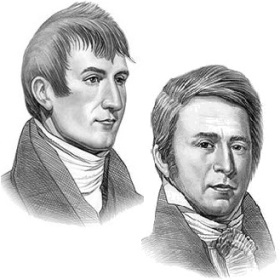|
|
|
|
|
|
One of our hunters, a half Indian, brought us an account of his having to day passed a small lake, near which a number of deer were feeding, and in the pond he heard a snake making a guttural noise like a turkey. He fired his gun, but the noise became louder. He adds, that he has heard the Indians mention this species of snake, and this story is confirmed by a Frenchman of our party. All the next day, the river being very high, the sandbars were so rolling and numerous, and the current so strong, that we were unable to stem it even with oars added to our sails; this obliged us to go nearer the banks, which were falling in, so that we could not make, though the boat was occasionally towed, more than fourteen miles. We passed several islands and one creek on the south side, and encamped on the north opposite a beautiful plain, which extends as far back as the Osage river, and some miles up the Missouri. In front of our encampment are the remains of an old village of the Little Osage, situated at some distance from the river, and at the foot of a small hill. About three miles above them, in view of our camp is the situation of the old village of the Missouris after they fled from the Sauks. The inroads of the same tribe compelled the Little Osage to retire from the Missouri a few years ago, and establish themselves near the Great Osages. The river, which is here about one mile wide, had risen in the morning, but fell towards evening.
June 16, 1804
June 16, 1804 The mosquitoes and other animals are so troublesome that mosquito biers or nets were distributed to the party. The next morning we passed a large island, opposite to which on the north is a large and beautiful prairie, called Sauk prairie, the land being fine and well timbered on both sides the river. Pelicans were seen to day. We made six and three quarter miles, and encamped at the lower point of a small island, along the north side of which we proceeded the next day, June 21st, but not without danger in consequence of the sands and the rapidity of the water which rose three inches last night. Behind another island come in from the south two creeks, called Eau, Beau, or Clear Water creeks; on the north is a very remarkable bend, where the high lands approach the river, and form an acute angle at the head of a large island produced by a narrow channel through the point of the bend. We passed several other islands, and encamped at seven and a half miles on the south. |
| Mobile Website Menu |
|
|
|
Published 2015 |
Modified 2018 |

